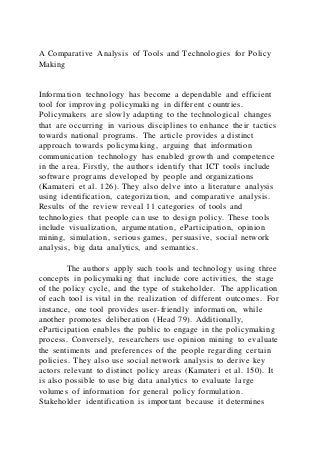A Comparative Analysis of Tools and Technologies for Policy Making
A Comparative Analysis of Tools and Technologies for Policy Making Information technology has become a dependable and efficient tool for improving policymaking in different countries. Policymakers are slowly adapting to the technological changes that are occurring in various disciplines to enhance their tactics towards national programs. The article provides a distinct approach towards policymaking, arguing that information communication technology has enabled growth and competence in the area. Firstly, the authors identify that ICT tools include software programs developed by people and organizations (Kamateri et al. 126). They also delve into a literature analysis using identification, categorization, and comparative analysis. Results of the review reveal 11 categories of tools and technologies that people can use to design policy. These tools include visualization, argumentation, eParticipation, opinion mining, simulation, serious games, persuasive, social network analysis, big data analytics, and semantics. The authors apply such tools and technology using three concepts in policymaking that include core activities, the stage of the policy cycle, and the type of stakeholder. The application of each tool is vital in the realization of different outcomes. For instance, one tool provides user-friendly information, while another promotes deliberation (Head 79). Additionally, eParticipation enables the public to engage in the policymaking process. Conversely, researchers use opinion mining to evaluate the sentiments and preferences of the people regarding certain policies. They also use social network analysis to derive key actors relevant to distinct policy areas (Kamateri et al. 150). It is also possible to use big data analytics to evaluate large volumes of information for general policy formulation. Stakeholder identification is important because it determines methods for achieving effective policies. Policymakers should consider target activities and the policymaking stage while selecting ICT tools and technologies. Evidently, these approaches provide significant insight regarding the approach that policymakers can use to obtain and implement certain policies. Question: Which is the best tool for creating policies on the attainment and distribution of water within the community? Works Cited Head, Brian W. “Reconsidering Evidence-Based Policy: Key Issues and Challenges.” Taylor & Francis, 2010, pp. 77-94. Kamateri, Eleni, et al. “A Comparative Analysis of Tools and Technologies for Policy Making.” Policy Practice and Digital Science: Integrating Complex Systems, Social Simulation and Public Administration in Policy Research , edited by Marijn Janssen, Maria A. Wimmer, and Ameneh Deljoo, Springer, 2015, pp. 125-156. ...

Recommended
Recommended
More Related Content
More from mecklenburgstrelitzh
More from mecklenburgstrelitzh (20)
A Comparative Analysis of Tools and Technologies for Policy Making
- 1. A Comparative Analysis of Tools and Technologies for Policy Making Information technology has become a dependable and efficient tool for improving policymaking in different countries. Policymakers are slowly adapting to the technological changes that are occurring in various disciplines to enhance their tactics towards national programs. The article provides a distinct approach towards policymaking, arguing that information communication technology has enabled growth and competence in the area. Firstly, the authors identify that ICT tools include software programs developed by people and organizations (Kamateri et al. 126). They also delve into a literature analysis using identification, categorization, and comparative analysis. Results of the review reveal 11 categories of tools and technologies that people can use to design policy. These tools include visualization, argumentation, eParticipation, opinion mining, simulation, serious games, persuasive, social network analysis, big data analytics, and semantics. The authors apply such tools and technology using three concepts in policymaking that include core activities, the stage of the policy cycle, and the type of stakeholder. The application of each tool is vital in the realization of different outcomes. For instance, one tool provides user-friendly information, while another promotes deliberation (Head 79). Additionally, eParticipation enables the public to engage in the policymaking process. Conversely, researchers use opinion mining to evaluate the sentiments and preferences of the people regarding certain policies. They also use social network analysis to derive key actors relevant to distinct policy areas (Kamateri et al. 150). It is also possible to use big data analytics to evaluate large volumes of information for general policy formulation. Stakeholder identification is important because it determines
- 2. methods for achieving effective policies. Policymakers should consider target activities and the policymaking stage while selecting ICT tools and technologies. Evidently, these approaches provide significant insight regarding the approach that policymakers can use to obtain and implement certain policies. Question: Which is the best tool for creating policies on the attainment and distribution of water within the community? Works Cited Head, Brian W. “Reconsidering Evidence-Based Policy: Key Issues and Challenges.” Taylor & Francis, 2010, pp. 77-94. Kamateri, Eleni, et al. “A Comparative Analysis of Tools and Technologies for Policy Making.” Policy Practice and Digital Science: Integrating Complex Systems, Social Simulation and Public Administration in Policy Research , edited by Marijn Janssen, Maria A. Wimmer, and Ameneh Deljoo, Springer, 2015, pp. 125-156.